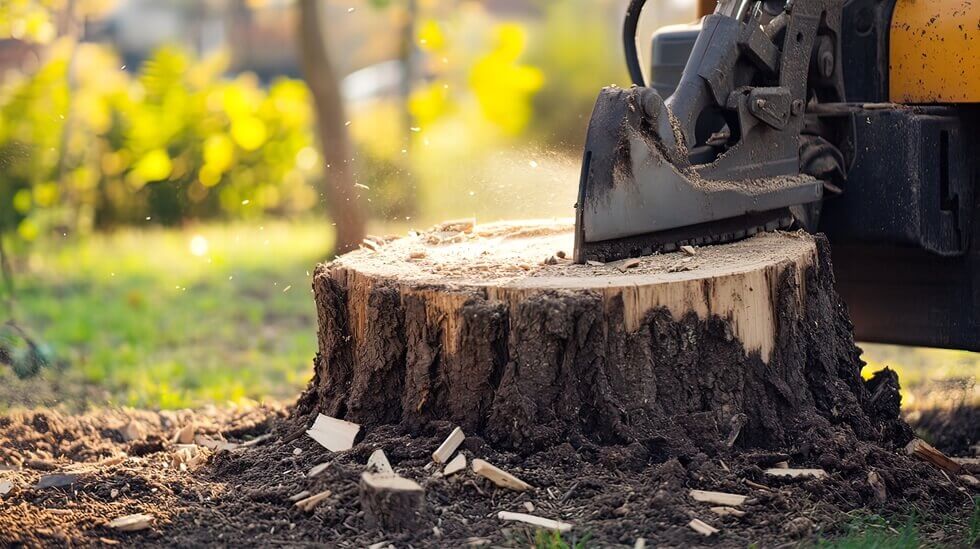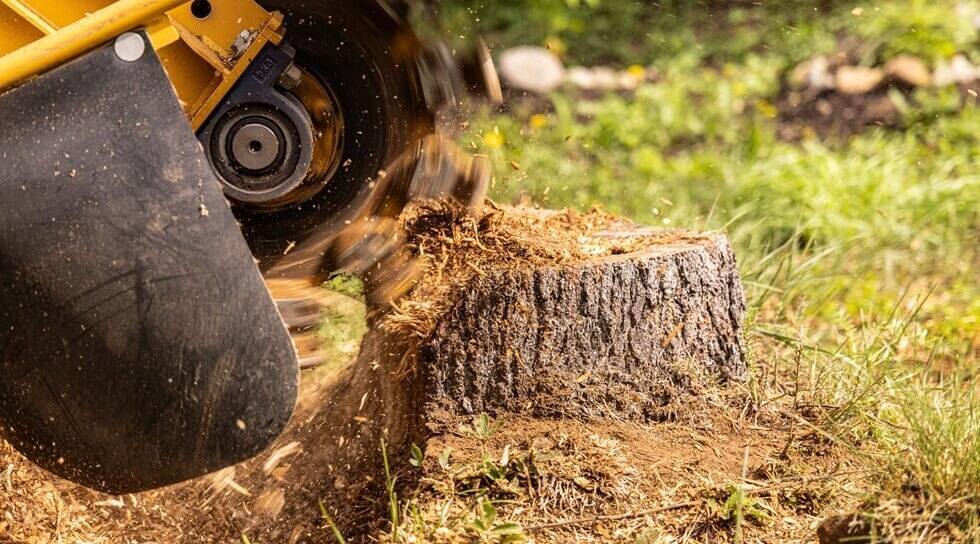When trees are removed due to disease, damage, decay, or other factors, property owners have to decide what to do with the stump. Tree stumps are unattractive, but they can also present hazards by creating obstacles for walkers and mowers, attracting pests, infesting the landscape with fungal growths, or hindering soil health. If ignored for long enough, the problematic tree may begin to grow back.
When choosing between stump removal and stump grinding, be sure to carefully compare the different benefits, challenges, and procedures of these two options. This article defines these differences to help owners decide how best to remove unsightly stumps from their property.

What is Stump Removal?
Stump removal entails digging out the stump, including the root ball. This method comes with several benefits to property owners, including:
- Eliminates the root system, reducing the possibility of regrowth
- Clears the space to allow for construction, replanting, or relandscaping
- Removes the entire structure to prevent future root decay or soil health issues
- Lowers the chance of liability claims by removing a potential obstacle
- Destroys potential pest infestations in the remaining structure
Stump removal is a long-term solution to the problem, reducing the need for further maintenance to monitor for root decay or new sprouts.
However, stump removal has limitations that may prevent property owners from using this method, including:
- Heavy machinery used disrupts the surrounding landscape
- Labor and equipment make it more expensive than other options
- Removal leaves an exposed excavation site that may require filling or grading
These limitations impact the viability of stump removal for certain properties, suggesting the need for an alternative solution.
What is Stump Grinding?
Stump grinding is the main alternative to stump removal, involving the use of tools to grind the stump down below ground level. Normally, the resulting base will sit 4-6 inches below the soil line, out of the way of the above-ground property. Yet, unlike stump removal, the stump grinding process leaves the root structure in place. These roots eventually decay on their own, allowing the stump to be removed more naturally.
The benefits of stump grinding compared to stump removal center around this gentler approach to dealing with unwanted stumps:
- Higher efficiency: Compared to stump removal, stump grinding is a more efficient way to make the property safe. Stump grinding doesn’t require the same heavy equipment and can usually be completed in a few hours.
- Less disruption: Grinding doesn’t require large-scale soil excavation, meaning the surrounding landscape can remain mostly untouched.
- Less costly: Without the need for heavy machinery, the labor and removal costs tend to be much lower with stump grinding.
- Recycling opportunity: Once ground, the stump material can be useful to the property owner as natural mulch or compost.
Despite the many benefits of stump grinding, there are a few potential drawbacks:.
- Longer decomposition: The stump remains in the ground, leading to a much longer decomposition process as roots fully break down over months or years.
- Future obstacles: During the decomposition period, future planting, excavation, or building may be impeded by the remaining stump structure.
- Potential regrowth: Tree roots can remain alive for years even after the body of the stump has been ground away, potentially leading to regrowth.
- Monitoring required: Long-term monitoring is necessary to prevent unexpected regrowth and ensure complete eradication of the tree.
How to Choose Between Stump Removal and Grinding
Recognizing the pros and cons of stump removal and grinding, property owners should consider their goals and their property’s future when choosing between them.
When to Choose Stump Removal
Stump removal may be advantageous for property owners who plan to use the exact space for new developments, including excavation, planting, or construction. By removing the stump completely, they can eliminate the chances of new growth. This suggests that trees more prone to regrowing from roots alone, including maple and elm, may warrant removal.
When to Choose Stump Grinding
Stump grinding provides a more affordable alternative to removal for property owners on a tighter budget. It is also a much faster process, which may be a priority depending on the owner’s immediate plans for their landscape. Additionally, grinding is preferable to removal in tight areas or those surrounded by utilities or other landscaped elements, where heavy machinery excavation could do irreparable damage.

Partner with RTEC Treecare to Compare Stump Removal and Grinding in Your Situation
When it comes to managing your landscape, choosing between stump removal and grinding is a decision that impacts your property’s long-term health and appearance. At RTEC Treecare, we understand the benefits and challenges each method presents. Our certified arborists conduct comprehensive property assessments to determine the most effective solution for your specific needs, whether it’s complete stump removal or efficient grinding.
Don’t let unwanted stumps compromise your landscape’s beauty and safety. Contact RTEC Treecare today for a free consultation. Our experts will guide you through the pros and cons of stump removal vs. grinding, ensuring you make an informed decision that aligns with your property goals. Visit our website to schedule your personalized tree care evaluation. Let’s work together to enhance your outdoor space and protect your property’s value.


